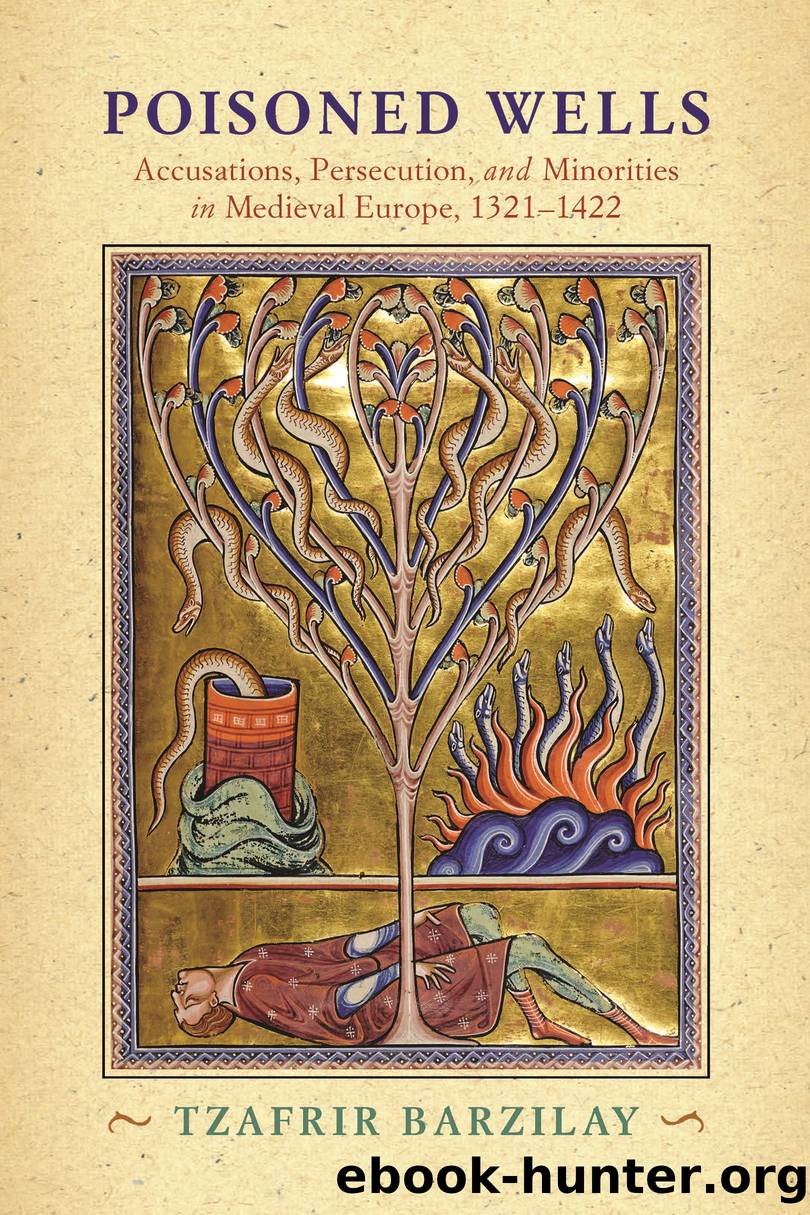Poisoned Wells by Tzafrir Barzilay;

Author:Tzafrir Barzilay;
Language: eng
Format: epub
Publisher: Lightning Source Inc. (Tier 2)
It is much clearer that well-poisoning accusations reappeared in Alsace and the western Alps, as an interrogation summary preserved in Strasbourg attests.6 The summary records accusations made against a Jewish woman, Hanne von Ehingen, in late 1379. Hanne and several other Jews were probably arrested in Schallstadt and brought to Strasbourg for further interrogation and judgment. She confessed, perhaps under torture, to different crimes, including fraud and murder, but the main charge was well poisoning. Allegedly, Hanne and two other Jews from Munich, both named Samuel, killed her son. They then used the boyâs blood and feces to create a poisonous powder, which they threw in different wells. The same document relates that five other Jews spread poison around Alsace, particularly in Strasbourg, Breisach, Schallstadt, and Colmar. For example, it states that Salmon (Solomon) the Jew scattered poison produced from rotten meat throughout Colmar and Schallstadt.7 After her interrogation, Hanne asked whether conversion would save her from the stake and received a negative answer; she thus decided to die as a Jew.8 While other suspects were likely executed as well, it is uncertain whether the persecution extended beyond this group.
The plot was presented as originating in Bavaria: the two Jews who purportedly produced the poison with Hanne came from Munich, and Salmon was said to receive his poison from Ingolstadt. The fact that 1379 was a plague year in Bavaria could have been related to the accusations in Alsace.9 The earlier history of well-poisoning allegations against Jews in Alsace, and particularly in Schallstadt and Strasbourg, surely played a part, too.10 Thirty years after the first appearance of the Black Death, the Jews who returned to Alsace were still occasionally suspected of causing recurring episodes of the disease. Still, the scope of the persecution in 1379 was very limited in comparison to 1349.
In the same year, an artisan from Zurich named Welti Grebel claimed that Jews had poisoned one well in the Niederdorf neighborhood and another near St. Leonhard.11 Notes of the city council, documenting his claims, do not mention any associated anti-Jewish violence. Possibly, the same rumors that circulated in Alsace reached the city. Although, as in Alsace, Jews had been accused of well poisoning in Zurich in 1349, authorities did not acknowledge the new allegations.12
Other cases of well-poisoning accusations occurred in Alsace in 1397, a plague year.13 On 23 June, officials from Colmar responded to their counterparts in Freiburg, who had inquired regarding rumors that local Jews had once again plotted against Christians. The Colmar authorities stated only that one Jew was arrested in nearby Ribeauvillé and another in Turckheim. Sometime later, records of the interrogation of both Jews were sent to Freiburg from Colmar. The Jew arrested at Ribeauvillé, Meiger (Meir) of Aschaffenburg, was forced to confess to organizing a network of Jewish poisoners around Colmar. Allegedly, after he had received some poisonous powder from a Jew from Schaffhausen in a field, Meir and other Jews threw it in a well near Sigolsheim and in other nearby wells.
Download
This site does not store any files on its server. We only index and link to content provided by other sites. Please contact the content providers to delete copyright contents if any and email us, we'll remove relevant links or contents immediately.
Cecilia; Or, Memoirs of an Heiress — Volume 1 by Fanny Burney(32062)
Cecilia; Or, Memoirs of an Heiress — Volume 3 by Fanny Burney(31458)
Cecilia; Or, Memoirs of an Heiress — Volume 2 by Fanny Burney(31409)
The Secret History by Donna Tartt(18163)
Sapiens: A Brief History of Humankind by Yuval Noah Harari(13991)
Leonardo da Vinci by Walter Isaacson(12804)
The Radium Girls by Kate Moore(11621)
Sapiens by Yuval Noah Harari(5123)
How Democracies Die by Steven Levitsky & Daniel Ziblatt(4958)
The Wind in My Hair by Masih Alinejad(4843)
Homo Deus: A Brief History of Tomorrow by Yuval Noah Harari(4690)
Endurance: Shackleton's Incredible Voyage by Alfred Lansing(4507)
Man's Search for Meaning by Viktor Frankl(4275)
The Silk Roads by Peter Frankopan(4274)
Millionaire: The Philanderer, Gambler, and Duelist Who Invented Modern Finance by Janet Gleeson(4099)
The Rape of Nanking by Iris Chang(4023)
Hitler in Los Angeles by Steven J. Ross(3798)
The Motorcycle Diaries by Ernesto Che Guevara(3787)
Joan of Arc by Mary Gordon(3782)
